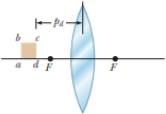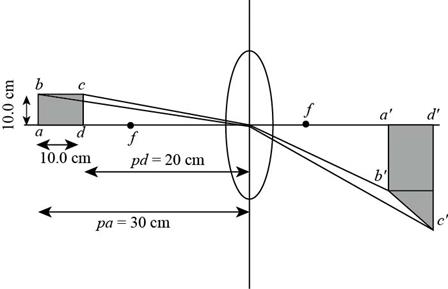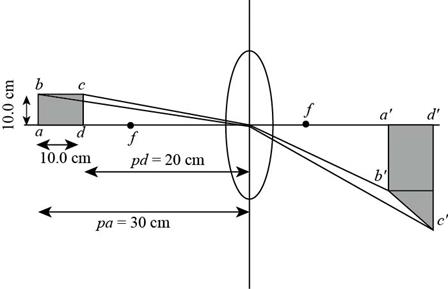
Concept explainers
In Figure P35.30, a thin converging lens of focal length 14.0 cm forms an image of the square abed, which is he = hb = 10.0 cm high and lies between distances of pd = 20.0 cm and pa = 30.0 cm from the lens. Let a′, b′, c′. and d′ represent the respective corners of the image. Let qa represent the image distance for points a′ and b′, qd represent the image distance for points c′ and d′,
where h′ and q are in centimeters. (d) Explain why the geometric area of the image is given by
(e) Carry out the integration to find the area of the image.
Figure P35.30

(a)
Answer to Problem 36.50P
Explanation of Solution
Given info: The focal length of the lens is
Formula to calculate the image of any object in a thin lens is,
Here,
Substitute
Here,
Substitute
Substitute
Here,
Substitute,
Formula to calculate the height of the corresponding image point

Here,
Substitute
For calculating the image height corresponding to
Substitute
Conclusion:
Therefore, the values of
(b)
To draw: The sketch of the ray diagram.
Answer to Problem 36.50P

Explanation of Solution
The image of the square

Figure (1)
(c)
To show: The relation,
Answer to Problem 36.50P
Explanation of Solution
Here,
From the lens,
Here,
Substitute
Substitute
Conclusion:
Therefore the relation between height of the image and the image distance is
(d)
To write: The explanation that the geometric area of image is
Answer to Problem 36.50P
Explanation of Solution
Given info: The geometric area of a image is,
Here,
From equation (10) the integral sums up the small areas of region covered by the image itself. The height of the small regions is
Therefore area of that small region is
Therefore the integration from
Conclusion:
Therefore, the geometric area of the image is given by integral
(e)
Answer to Problem 36.50P
Explanation of Solution
Given info: The geometric area of the image is given by the integral,
From equation (9) substitute
Integrate the above equation with respect to
Conclusion:
Therefore, the geometric area of the image is
Want to see more full solutions like this?
Chapter 36 Solutions
EBK PHYSICS FOR SCIENTISTS AND ENGINEER
- Need complete solution Pleasearrow_forwardBelow you will find 100 m split times for the American and France men’s 4x100 meter free style relay race during the 2008 Beijing Summer Olympics). Fill out the chart below. Calculate average speed per split (m/s). Show all work.arrow_forwardThe magnitude of vector →A i s 261. m and points in the direction 349.° counterclockwise from the positive x-axis. Calculate the x-component of this vector . Calculate the y-component of this vector.arrow_forward
- No chatgpt plsarrow_forward4.4 A man is dragging a trunk up the loading ramp of a mover's truck. The ramp has a slope angle of 20.0°, and the man pulls upward with a force F whose direction makes an angle of 30.0° 75.0° with the ramp (Fig. E4.4). (a) How large a force F is necessary for the component Fx parallel to the ramp to be 90.0 N? (b) How large will the component Fy perpendicular to the ramp be then? Figure E4.4 30.0 20.0°arrow_forward1. * A projectile is shot from a launcher at an angle e, with an initial velocity magnitude v., from a point even with a tabletop. The projectile lands on the tabletop a horizontal distance R (the "range") away from where it left the launcher. Set this up as a formal problem, and solve for vo (i.e., determine an expression for Vo in terms of only R, 0., and g). Your final equation will be called Equation 1.arrow_forward
- 2. A projectile is shot from a launcher at an angle 0,, with an initial velocity magnitude vo, from a point even with a tabletop. The projectile hits an apple atop a child's noggin (see Figure 1). The apple is a height y above the tabletop, and a horizontal distance x from the launcher. Set this up as a formal problem, and solve for x. That is, determine an expression for x in terms of only v₁, o,y and g. Actually, this is quite a long expression. So, if you want, you can determine an expression for x in terms of v., 0., and time t, and determine another expression for timet (in terms of v., 0., y and g) that you will solve and then substitute the value of t into the expression for x. Your final equation(s) will be called Equation 3 (and Equation 4).arrow_forward4.56 ... CALC An object of mass m is at rest in equilibrium at the origin. At t = 0 a new force F(t) is applied that has components Fx(t) = k₁ + k₂y Fy(t) = k3t where k₁, k2, and k3 are constants. Calculate the position (1) and veloc- ity (t) vectors as functions of time.arrow_forward4.14 ⚫ A 2.75 kg cat moves in a straight line (the x-axis). Figure E4.14 shows a graph of the x- component of this cat's velocity as a function of time. (a) Find the maximum net force on this cat. When does this force occur? (b) When is the net force on the cat equal to zero? (c) What is the net force at time 8.5 s? Figure E4.14 V₁ (m/s) 12.0 10.0 8.0 6.0 4.0 2.0 0 t(s) 2.0 4.0 6.0 8.0 10.0arrow_forward
 Physics for Scientists and EngineersPhysicsISBN:9781337553278Author:Raymond A. Serway, John W. JewettPublisher:Cengage Learning
Physics for Scientists and EngineersPhysicsISBN:9781337553278Author:Raymond A. Serway, John W. JewettPublisher:Cengage Learning Physics for Scientists and Engineers with Modern ...PhysicsISBN:9781337553292Author:Raymond A. Serway, John W. JewettPublisher:Cengage Learning
Physics for Scientists and Engineers with Modern ...PhysicsISBN:9781337553292Author:Raymond A. Serway, John W. JewettPublisher:Cengage Learning Principles of Physics: A Calculus-Based TextPhysicsISBN:9781133104261Author:Raymond A. Serway, John W. JewettPublisher:Cengage Learning
Principles of Physics: A Calculus-Based TextPhysicsISBN:9781133104261Author:Raymond A. Serway, John W. JewettPublisher:Cengage Learning Physics for Scientists and Engineers: Foundations...PhysicsISBN:9781133939146Author:Katz, Debora M.Publisher:Cengage Learning
Physics for Scientists and Engineers: Foundations...PhysicsISBN:9781133939146Author:Katz, Debora M.Publisher:Cengage Learning University Physics Volume 3PhysicsISBN:9781938168185Author:William Moebs, Jeff SannyPublisher:OpenStax
University Physics Volume 3PhysicsISBN:9781938168185Author:William Moebs, Jeff SannyPublisher:OpenStax Glencoe Physics: Principles and Problems, Student...PhysicsISBN:9780078807213Author:Paul W. ZitzewitzPublisher:Glencoe/McGraw-Hill
Glencoe Physics: Principles and Problems, Student...PhysicsISBN:9780078807213Author:Paul W. ZitzewitzPublisher:Glencoe/McGraw-Hill





